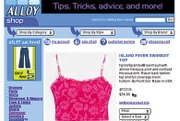Alloy Strikes Gold
The trials and tribulations of building a successful fashion-focused multichannel teen portal—a project that began for CEO Matt Diamond back in Harvard Business School some years ago—have finally paid off: Alloy Online is profitable! Alloy Online, Inc. (Nasdaq:ALOY) [www.alloy.com], a leading Gen Y-focused media company and direct marketer, is projecting total revenues in the coming year of $140 million to $145 million. In the midst of dot-com failures and generally stalled e-commerce growth (not to mention the overall economic downturn), this approaches the miraculous.
In a recent press release, a gleeful Diamond said: “Continued strong growth in our high-margin sponsorship revenue stream clearly demonstrates that we have become one of the primary resources for a wide variety of companies that want to understand and reach the robust teen market through a variety of mediums. Our commerce business continues to be a major revenue engine and is growing at a rapid pace in both the girls’ and boys’ side of the Generation Y demographic.”
Alloy’s consolidated database of Gen Y girls and boys reached approximately 6.6 million names by Jan. 31, 2001, approximately 1.5 million of which were established buyers. This was up from approximately 3.8 million total names and 520,000 established buyers as of Jan. 31, 2000. Alloy’s registered online user base grew to approximately 3.7 million registrants by Jan. 31, 2001, from approximately 1.7 million by Jan. 31, 2000.
Alloy has innovated on many levels, creating an online community that provides a wealth of content (Web site, catalog, newsletter) to support its commercial goal of selling fashion merchandise.
Online apparel report card
Overall, however, apparel shoppers who took to the Internet over the recent holiday season often met with a negative experience and reported mostly low expectations of returning to many of the fashion sites they had previously visited, according to a new study from consulting firm Accenture (formerly Andersen Consulting). Half of those surveyed for this “eHoliday 2000 Apparel Report Card” rated sites geared toward apparel merchandise as easy to use, while an alarming 47 percent reported that both shopping and transacting a purchase was difficult or very difficult. Of those in the dissatisfied category, 72 percent said they were unlikely to return to the site.
“Consumers expect the same experience whether shopping on- or offline,” Accenture retail managing partner Angela K. Selden noted on [www.ecommercetimes.com]. “With the functional improvements that retailers achieved in 2000, customer service now becomes the linchpin for the year ahead.”
We would add one of Alloy.com’s lessons: Customers return when they are offered interesting, timely information, not just a barrage of products without any community or lifestyle-relevant context. Customer service is essential but only one of the qualities needed to succeed in e-commerce.
Banner plans
A successful Web portal/community usually includes “sponsorships”—advertisements tailored to the audience being courted and typically presented as graphic banners—though over the past two years diminishing returns have been noted. While 1.4 percent of typical viewers would actually “click-thru” an advertiser’s banner in 1997, today that’s down to 0.4 percent, according to research reported in the San Jose Business Journal. To counter this downturn, some portals are now adopting new standards that embrace much larger banners than have previously been on Web pages. These so-called “skyscraper” ads may actually be seen as content rather than simply promotion and can include coupons, with bar code and all, redeemable at bricks-and-mortar stores. “Rich media” with animations and even short video clips are being brought into the picture, too, anticipating the day when most Web users will be on broadband high-speed connections.






















